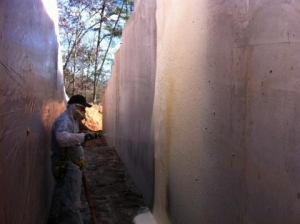 Building log homes in East Tennessee for many years, we are very familiar with building on steep, mountainous lots. While we understand that not all lots have the same advantages and disadvantages, it is from within our own background of experience that we note our ideas on using poured concrete walls vs block walls. Obviously, if local codes do not dictate special sizing of foundation wall materials, it is possible to find substantial savings in overall costs using block walls, but this isn’t always the best way to go.
Building log homes in East Tennessee for many years, we are very familiar with building on steep, mountainous lots. While we understand that not all lots have the same advantages and disadvantages, it is from within our own background of experience that we note our ideas on using poured concrete walls vs block walls. Obviously, if local codes do not dictate special sizing of foundation wall materials, it is possible to find substantial savings in overall costs using block walls, but this isn’t always the best way to go.
Poured concrete foundations, in our experience, have many advantages over block foundations. One primary advantage is concrete’s strength. The strength of a block foundation pales in comparison to that of a solid, poured concrete foundation, even when the block wall has been poured full of concrete after construction. Larger quantities and types of steel must often be utilized to add strength to the block foundation, thus adding considerable expense to the project.
Utilizing poured concrete foundations also allows the contractor to ensure the house is perfectly square before the wall has been poured, avoiding problems both in the building process and longer term. Because block is pre-made at an off-site location, variances in the blocks’ height, length, and width can sometimes occur. This can easily result in walls that are both out-of-square and uneven in height, and must be corrected on-site by the mason. This is sometimes only a minor problem if the mason is experienced; but, if not, problems are always more difficult to correct after the wall has been constructed versus before.
Poured concrete walls are far less porous than block walls. As an experiment, put a block in a pan of water and see what happens. The block will readily soak up the water in the pan. If an area of the foundation has a small spot of exposed block showing through the membrane sealer material, block walls will more quickly wick water from the ground, because they are much more porous, as compared to solid concrete walls. This can reduce the wall’s strength in some cases, and more importantly, draw in moisture, which can lead to mildew and mold inside the home. A very small area of non-coverage on the surface side of the block can result in a very large amount of wet block in the interior of the home.
At first glance, it may appear that block foundations are significantly less expensive than poured concrete. However, when one adds in the cost of labor to lay the block, and the expense of the extra steel to reinforce the block, along with the added expense of pouring the block full of special concrete, it becomes clear that these initial costs can be deceiving. Factor in the additional time it takes to lay the block foundation, and the added need of the foundation walls to be as accurate as possible for pre-cut log wall systems, and it becomes easy to see why poured concrete foundations are superior for log home construction.
It is important to note that, regardless of the foundation you choose, water-proofing systems must be utilized to ensure your foundation is sealed. We recommend using a specialized type of heated spray foam application to act as both a vapor and water barrier.
Items to keep in mind:
1. How close is the job site to a concrete or block company?
2. Is the site easily accessible by large trucks?
3. Has the site been reviewed by a Geotechnical Engineer?
4. Does the property have a sewer, or do you need to think about where the drain field of a septic system would be installed?
5. Will the home have a pre-cut log wall system? If so, the height of foundation plates and “squareness” of walls is a must.
6. Will the foundation walls need to be poured through the use of a pump truck or crane? If so, do you know the closest location or company?
You only get one chance to put in the foundation of your home the correct way! Take time to ensure everything has been planned out and prepared in advance.


